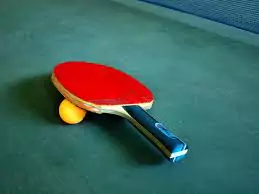 Table tennis, or ping pong, is a world-famous game. More than just tennis on a table, it is an essential racket sport of its own. Below, I will discuss its origins and how it became one of most renowned sports of human history.
Table tennis, or ping pong, is a world-famous game. More than just tennis on a table, it is an essential racket sport of its own. Below, I will discuss its origins and how it became one of most renowned sports of human history.

✅ AI Essay Writer ✅ AI Detector ✅ Plagchecker ✅ Paraphraser
✅ Summarizer ✅ Citation Generator
Like many other racket sports, table tennis began to take shape in England. In Victorian times, table tennis was a way for the upper-class to relax as a parlour game (Hodges, Larry). Most games and sports seem to derive from moments of fooling around or making fun activities. Victorian English people loved playing lawn tennis, and wanted to play indoor tennis on what they had around them.
This upper-class game was brought into the British military in India around the 1860s, and then brought back with new ideas. Piled up books on a table made a net, and a book in the hand became a paddle. The ball was usually a golf ball (A Comprehensive History of Table Tennis). As the game was played more and more in households, some people saw a business idea in it.
For instance, starting from 1901, “ping-pong” was trademarked and manufactured by British company J. Jaques & Son (Jaques London). The set was expensive and meant for the upper class. It had paddles, balls, and a net, but tables were not yet being made specifically for the game.
Though the game was still being played on makeshift surfaces, when James W. Gibb, a table tennis enthusiast, visited America in 1901, he came upon a new idea for the ball. In the US, there were celluloid balls that seemed ideal for ping pong. Gibb gladly brought it back to his homeland to spread the world about a better ball. Also in 1901, E.C. Goode created the modern table tennis racket by planting rubber over a wooden blade. With these quick developments, tournaments started being played, volumes were being written about the game, and the first (unofficial) world championship of table tennis was in 1902 (A Comprehensive History of Table Tennis).
Table tennis grew to greater heights of popularity with these competitions and better equipment. People began to treat the game more as a sport and something serious to play. By 1921, the first official organization for the game was created called the Table Tennis Association. However, in 1926, it changed its name to the English Table Tennis Association—probably to allow other countries to make their own associations (Itoh, M). In the same year, The International Table Tennis Federation (ITTF) was founded (Hodges, Larry).
With these organizations coming into existence, it seemed it was time to have an official world championship for the game. The city of London hosted the first official world champion of table tennis in 1926. There were single and team events, and surprisingly, Hungarians got gold in both categories.
After the success of the first official world championship, the sport moved to the US. By 1933, the United States Table Tennis Association was initiated (Hodges, Larry). However, in the 1930s, the Chinese Communist forces in the Chinese Civil War enjoyed the game, though in the Soviet Union the playing of the game waned due to misinformation that table tennis was bad for health (Федерация Настольного Тенниса России).
The final development in the game that brought it into modern times was the creation of the underlying sponge layer below the rubber sheet of the paddle. This made the game faster and introduced many spinning techniques. Even “speed glue” was added to increase the velocity and spin that could be created from the paddle. Ultimately, with the game so adored and developed, it become an olympic sport in 1988 (Hodges, Larry).
Starting from a casual game in upper-class homes of Victorian England, table tennis has become an olympic sport and a beloved game of millions. With the development of the racket over time, many spinning techniques, faster speed, and fresh strategies emerged. It looks like this once-parlour game is here to stay.
Works Cited
Hodges, Larry. Table Tennis: Steps to Success. Human Kinetics, 1993.
A Comprehensive History of Table Tennis. Fox News, web.archive.org/web/20150313051738/http://www.ittf.com/museum/history.html.
“Welcome to Jaques of London.” Jaques London, 14 May 2018, www.jaqueslondon.co.uk/.
Itoh, M. Origin of Ping-Pong Diplomacy: the Forgotten Architect of Sino-U.S. Rapprochement. Palgrave Macmillan, 2016.
“Отечественная История Настольного Тенниса.” Федерация Настольного Тенниса России, ttfr.ru/rus/russian_table_tennis_history/.
Follow us on Reddit for more insights and updates.





Comments (0)
Welcome to A*Help comments!
We’re all about debate and discussion at A*Help.
We value the diverse opinions of users, so you may find points of view that you don’t agree with. And that’s cool. However, there are certain things we’re not OK with: attempts to manipulate our data in any way, for example, or the posting of discriminative, offensive, hateful, or disparaging material.